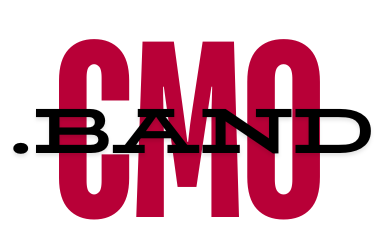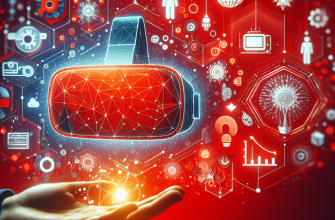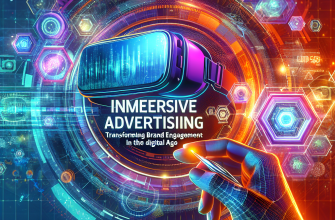Transforming B2B Engagement: The Power of Immersive Marketing Strategies
In the rapidly evolving landscape of digital marketing, the quest for more engaging, memorable, and effective strategies to captivate the B2B audience has led to the rise of immersive marketing. This innovative approach has revolutionized how businesses interact with their clients, offering a unique blend of interactivity, storytelling, and technology to create experiences that resonate on a deeper level.
The Essence of Immersive Marketing
Immersive marketing transcends traditional advertising by creating an environment that fully envelops the audience in the experience. It leverages cutting-edge technologies such as virtual reality (VR), augmented reality (AR), mixed reality (MR), and 360-degree video content to craft engaging narratives that transport users beyond the confines of their immediate surroundings. This strategy is not just about showcasing a product or service; it’s about weaving a compelling story that invites the audience to step into a world where they can interact with your brand in a meaningful way.
Why Immersive Marketing Resonates with B2B Audiences
The B2B sector, with its complex sales cycles and emphasis on relationship building, stands to gain significantly from immersive marketing strategies. Here’s why:
-
Enhanced Engagement: In a digital era where attention spans are shrinking, immersive experiences capture and retain the attention of B2B clients by offering them an active role in the narrative.
-
Deeper Emotional Connection: By engaging multiple senses, immersive marketing creates a powerful emotional connection, fostering brand loyalty and trust.
-
Complexity Simplified: B2B products and services can often be complex. Immersive experiences can simplify these concepts through interactive demonstrations and simulations, making them more accessible.
- Memorable Experiences: The novelty and interactivity of immersive marketing ensure that the experiences are memorable, increasing brand recall and differentiation in a crowded market.
Implementing Immersive Marketing in B2B Strategies
Adopting immersive marketing requires a blend of creativity, technology, and strategic thinking. Here are some steps to integrate immersive experiences into your B2B marketing strategy:
-
Start with Your Audience: Understand the needs, challenges, and preferences of your B2B audience. This insight will guide the design of your immersive experience to ensure it resonates and adds value.
-
Define Your Objectives: Clearly define what you want to achieve with your immersive marketing campaign. Whether it’s increasing brand awareness, generating leads, or educating your audience, your objectives will shape the narrative and technology you choose.
-
Choose the Right Technology: Select the technology that best fits your objectives and audience needs. VR can offer a fully immersive experience for detailed product demos, while AR might be ideal for interactive brochures or enhancing physical events.
-
Craft a Compelling Narrative: Storytelling is at the heart of immersive marketing. Develop a narrative that not only highlights your product or service but also engages your audience in an interactive journey.
- Measure and Optimize: Like any marketing strategy, it’s crucial to measure the effectiveness of your immersive experiences. Use analytics to track engagement, conversion rates, and ROI, and be prepared to adjust your approach based on feedback and results.
Case Studies: Immersive Marketing in Action
Several forward-thinking companies have successfully implemented immersive marketing strategies, setting benchmarks for the B2B sector. For instance, a leading software company used VR to create a virtual tour of its data centers, allowing clients to explore its infrastructure without the need for physical travel. Another example is an industrial equipment manufacturer that employed AR to help clients visualize how large machinery would fit within their existing facilities.
These examples underscore the versatility and impact of immersive marketing, demonstrating how it can be tailored to suit the unique needs and challenges of the B2B sector.
The Future of B2B Engagement
As technology continues to advance, the possibilities for immersive marketing will expand, offering even more innovative ways to engage B2B audiences. From interactive webinars that leverage AR to enhance learning, to MR applications that blend physical and digital elements for product demonstrations, the future of B2B engagement is bound to be exciting and transformative.
Embracing immersive marketing is not just about keeping pace with digital trends; it’s about reimagining how we connect with our audience. By offering experiences that are not just seen but felt, businesses can forge deeper connections, drive meaningful engagement, and ultimately, achieve a competitive edge in the digital era.
In a world where digital noise is louder than ever, immersive marketing offers a beacon of innovation and engagement. As we look forward, it’s clear that the businesses willing to invest in these rich, interactive experiences will be the ones leading the charge in transforming B2B engagement. The journey into immersive marketing is an adventure worth embarking on, promising not just a new way of storytelling, but a new era of digital marketing excellence.

A seasoned digital marketing strategist with over 8 years of experience across various areas of digital marketing, including SEO, SMM, PPC, content marketing, and email marketing. Specializes in transforming B2B, B2C, e-commerce, and SaaS businesses by creating effective go-to-market strategies and building thriving digital ecosystems. Known for a data-driven approach to optimizing campaigns and maximizing results.
“If your business is looking to scale or in need of a fresh perspective, feel free to contact”.





